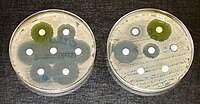
Photo from wikipedia
BACKGROUND Inflammation is associated with unfavorable clinical outcomes after aneurysmal subarachnoid hemorrhage (aSAH). We evaluated the relationship between postoperative neutrophil-to-albumin ratio (NAR) and unfavorable clinical outcomes (modified Rankin score ≥… Click to show full abstract
BACKGROUND Inflammation is associated with unfavorable clinical outcomes after aneurysmal subarachnoid hemorrhage (aSAH). We evaluated the relationship between postoperative neutrophil-to-albumin ratio (NAR) and unfavorable clinical outcomes (modified Rankin score ≥ 3) at hospital discharge in aSAH patients. METHODS Five hundred sixty aSAH patients undergoing surgical or endovascular treatment were included in this retrospective study. Patients were initially allocated to high (n=247) or low (n=313) postoperative NAR groups based on the immediate postoperative NAR cutoff value identified by receiver operating characteristic analysis, and then further subclassified into 4 groups: HH (high pre- and high postoperative NAR, n=156), LH (low preoperative and high postoperative NAR, n=91), HL (high preoperative and low postoperative NAR, n=68), and low pre- and low postoperative NAR (n=245). RESULTS Optimum cutoff values of immediate postoperative and preoperative NAR were 2.45 and 2.09, respectively. Unfavorable clinical outcomes were more frequent in patients with high compared with low postoperative NAR (45.3% vs. 13.4%; P < 0.001). In multivariate analysis, postoperative NAR was a significant predictor of unfavorable clinical outcomes (odds ratio, 2.10; 95% CI, 1.42-3.10; P < 0.001). Unfavorable clinical outcomes were less frequent in group low pre- and low postoperative NAR than in groups HH, LH, and HL (9.4% vs. 44.9%, 46.2% and 27.9%, respectively; all P < 0.001) and also in Group HL compared with groups HH and LH (P=0.026 and P=0.030); clinical outcomes did not differ between Groups HH and LH. CONCLUSIONS A high immediate postoperative NAR was associated with unfavorable clinical outcomes at hospital discharge in aSAH patients.
Journal Title: Journal of neurosurgical anesthesiology
Year Published: 2023
Link to full text (if available)
Share on Social Media: Sign Up to like & get
recommendations!